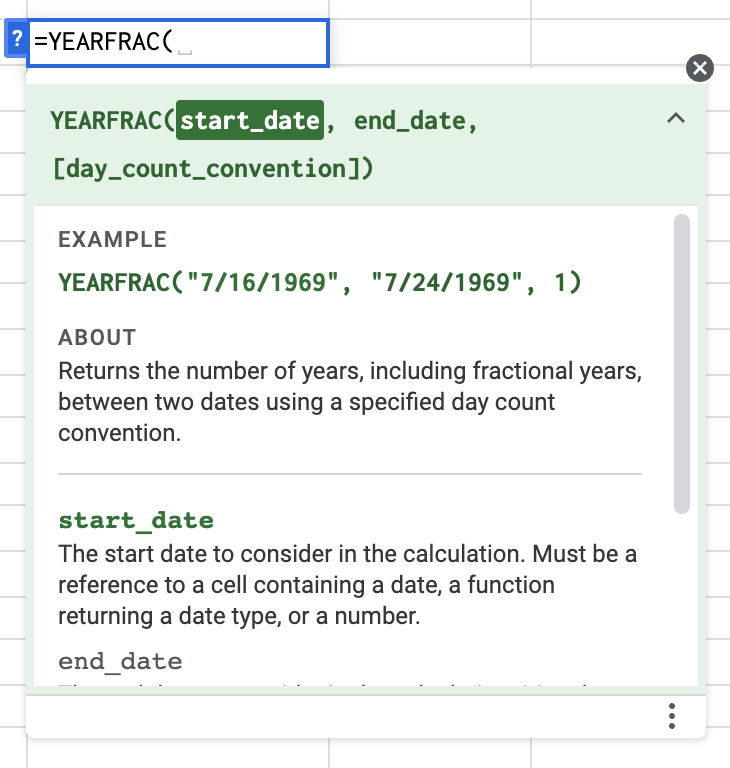The YEARFRAC function takes two dates and returns the years between them, including fractions of a year. You can optionally specify different methods of counting days.
This function can be used to calculate someone’s age. An alternative to YEARFAC is DATEDIF which can return the difference between two days in years, months, or days. To return the difference between times on different dates, use the TIMEDIF Google Sheets add-on.
Remember that dates are just saved as numbers by your spreadsheet with date formatting applied. The date must be in a valid format, so you must use the DATE function, wrap it in quotes, or use a cell reference to a cell containing a date.

Contents
Syntax
=YEARFRAC(start_date,end_date,[day_count_convention])
start_date– The date for the calculation to start.end_date– The date for the calculation to end.day_count_convention– Optional day count method.0[or blank] – US (NASD) 30/3601– actual/actual Uses the actual number of days.2– actual/360 Uses the actual number of days but with a 360-day year.3– actual/365 Uses the number of days but assumes a 365-day year. This option doesn’t recognize leap year.4– European 30/360 Similar to 0 but uses European standards instead of US.
Related Functions
DATE – Takes separate year, month, and day values and returns them as a date
DATEDIF – Calculates the difference between two days in years, days, and months
DAY – Returns the value of the day from a given date
DAYS360 – Calculates interest using the 360 method
TIMEDIF – Google Sheets Add-On
Calculate any duration in:
- Years
- Months
- Weeks
- Days
- Hours
- Minutes
- Seconds
- Milliseconds
Errors
#NUM – An input is a number but is not a valid date.
#VALUE! – The input doesn’t convert to a number, such as “The other day” or “Yester-yester-day.”
YEARFRAC Function Examples
Example 1 – Different Count Conventions
The function has five possible values for the day_count_convention. Their outputs are slightly different, as shown in the examples below and the linked Sheet.

When using YEARFRAC in Google Sheets in a general situation, such as calculating someone’s age, the actual/actual method is the clearest choice. This method uses the actual days elapsed divided by the actual days in a year.
Example 2 – Calculating Age with YEARFRAC
When combined with the TODAY function, we can calculate age.

=YEARFRAC(A2,TODAY(),1)
The result will update every subsequent day you open the spreadsheet as the value of TODAY will change.
Example 3 – Calculating Age in Whole Years
Let’s add to our last example by converting the result of the formula to an integer. This is done using the INT function.

=INT(YEARFRAC(A2,TODAY(),1))
Adding the INT function allows us to provide age as a whole number.
Example 4 – YEARFRAC in Finance
We used the actual/actual year convention setting of 1 in examples 2 and 3 because it counts the actual days. However, interest calculations often use a 360-day year, with each month having 30 days. Let’s use the 0 year day_count_convention for that.

=YEARFRAC(D2,E2,0)*C2*A2
We calculated the interest incurred on this loan with only one formula using the principal amount, rate, and two dates.
Live Examples in Sheets
Go to this spreadsheet for the examples of the YEARFRAC function shown above that you can study and use anywhere you would like.

